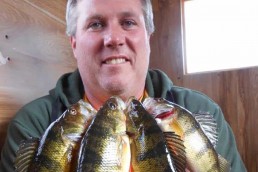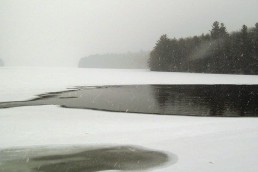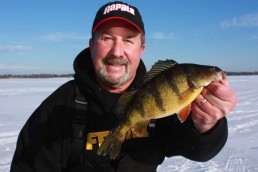Jumbo Perch and More: Timing the Late-ice Bite
SHARE THIS POST
March can be madness in more places than just on the basketball court. This can also happen on the lakes when crappies, sunfish and perch really go on the chew. Most other species are also active now depending on which exact seasons are open where anglers are fishing.
The season for walleyes, northern pike and saugers are closed in the inland lakes of Minnesota in March, but the seasons are open in some of the neighboring states and in some border waters of Minnesota. When I have an open date in my March calendar I like to make daytrips to Lake of the Woods for walleyes and saugers or spend a couple of days fishing jumbo perch and walleyes in Devils Lake, N.D.
March is busy for my winter guiding business, and I usually target perch or crappies on late ice for my clients. The numbers of big perch are on the rebound in many lakes in my area with several large age-classes of perch coming up in the fishing pipeline.
Anglers still have to sort through a lot of smaller perch to catch some cleanable-sized perch along with a few jumbos. I’ve been trying to discourage my guiding clients from targeting perch while most are still located in deep water. Barotrauma (the bends) is pretty hard on perch, especially when they are coming from water deeper than 25 feet. I don’t want my clients having to sort through a bunch of smaller perch in the deeper water if these fish are not going to be able to go back down to the bottom successfully when released. When the numbers of large perch are down I like to wait until many of them have moved into shallower water before targeting them with clients, so releasing the smaller perch is not an issue.
Trout and northern pike have less trouble with barotrauma than most species. Walleyes, saugers, perch, crappies and sunfish are all susceptible with susceptibility worsening the deeper the water gets.
Most fish leave deeper waters in late February through early March. The timing and progression of the fish movements in spring toward shallower water usually depends both on the length of the days and the weather patterns. March can see swings in the weather in Minnesota as the jet stream moves north and south. The melting snow running into lakes often plays a role in determining when fish move into shallower water. The fresh oxygen from the melting snow revitalizes the shallows and often causes crappies and sunfish to feed closer to the bottom of the ice to take advantage of the feeding opportunity created by freshwater flowing in.
If anglers know the location of the crappies during the winter and where the crappies will likely be going in early spring, then it’s only a matter of connecting the dots to find them during late ice.
Crappies have become my new favorite fish for guiding the last couple of winters due to the lower numbers of big perch as well as my reluctance to sort through small perch or other fish coming out of deep water. My area has some really big crappies too, with a good mix of those in lakes that have different sizes and numbers of fish. Some have mostly large crappies, while other lakes have a mix of sizes with a few that have a strong age-class or two of crappies at the perfect eating size.
Are you enjoying this post?
You can be among the first to get the latest info on where to go, what to use and how to use it!
Once crappies start to leave the deep water I’ll head closer to shore in the direction of their spring locations. I use the LakeMaster chip on my Humminbird Helix 7 to look for structures that are located between their winter and spring locations that might appeal to crappies. The first thing crappies do when they leave the deeper holes is to start suspending farther off the bottom and head for the nearest breakline. This species likes to hold off the sides of structure when they’re inactive and move into structure when they get active.
Each lake gives crappies different options. The types of locations crappies use are mid-depth flats where they roam for minnows and insects. Some lakes may have standing vegetation like cabbage, coontail or milfiol that’s still partially green that they can use to feed. Other lakes may have brush piles or timber, so crappies may be feeding in the wood or in the weed stubble.
The shoreline break is often the only structure available to crappies in lakes so they move along the breaklines or up and down them when feeding. These fish may be concentrated on inside turns, points or along the steepest sections of a breakline.
When searching, I figure out where they’re located then dial them in once I do. Crappies are almost always part of a school, so catching one can give away the location of the rest. And if in a new area, I drill a line of holes and move from hole to hole quickly. For this, I prefer a longer rod with a straight-line reel.
I like to use a small spoon like the Northland Forage Fry or the smallest-sized Puppet Minnow. I’ll also have a second rod rigged with a Bro Mud Bug and a Skeleton Impulse Minnow if fish won’t take jigging lures.
Once I find a school of crappies, I use my underwater camera to get a look at the size “structure” of the crappies. Here’s a little secret: I like to leave the infrared light on when searching for crappies, even in the daylight, because it makes their silver sides flash in the light so I can see them at longer distances.
By the end of the ice fishing season the crappies usually move again. They might be right up against the cattails, in wild rice beds or on the edges of reed beds. The best areas are often the patches of weeds with the deepest water or ones with the most direct access to deeper water.
MWO
SHARE THIS POST
Did you enjoy this post?
You can be among the first to get the latest info on where to go, what to use and how to use it!
Brian 'Bro' Brosdahl
Outdoor communicator Brian “Bro” Brosdahl lives in northern Minnesota. He is a walleye guide in the Cass Lake, Leech Lake and Lake Winnibigoshish areas. He is sponsored by Northland Fishing Tackle, Frabill/Plano, Aqua-Vu, Humminbird/Minn Kota, St. Croix Rods, Ranger Boats, and Evinrude. Guide inquiries: brosguideservice.com. Follow on social media.



